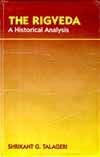|
Chapter 8 (Appendix 1)
Misinterpretations of Rigvedic History
 Page 1
Page 1
The Rigveda, as we have seen in this book, contains a veritable treasury of information which sheds light on the early history of the Vedic Aryans, and of the Indo-Europeans as a whole.
But why, inspite of the fact that the Rigveda has been a subject of historical study for nearly two centuries, was this wealth of information left untapped? Why did the scholars fail to discover all this evidence?
The answer is that scholars engaged in the historical interpretation of the Rigveda have never really found it necessary to examine the actual information in the Rigveda. All interpretations have been based on purely extraneous factors, and the Rigveda itself has never been required to play more than an incidental, and dispensable, role in these exercises.
To be specific, one extraneous factor has been responsible for all the misinterpretations of Rigvedic history to date: the erroneous belief that linguists have established, on the basis of comparative philology, that the original homeland of the Indo-European or Aryan family of languages was located in and around South Russia, or, at any rate, that it was located outside India.
This belief has influenced the interpretations not only of those scholars who claim to subscribe to it, but, as we shall see, also of those who claim not to subscribe to it.
It will be necessary to examine why exactly scholars, belonging to different schools of interpretation, failed to tap the basic information in the Rigveda. We will not go into details about everything said and written by these scholars: given the facility with which many of these scholars have written out pages and pages, even tomes and tomes, of pure drivel, based only on an active imagination and an evident contempt both for facts and logic, as well as for the source-material, it would be an impossible as well as a fruitless task to go into all their writings in detail here. That can always be a subject for deeper analysis elsewhere.
But it will be in order to examine generally the beliefs, the concerns, the aims and motives, and the obsessions, as well as the methods, which led the scholars into analyses and conclusions so completely divorced from the facts.
But, first and foremost, we must understand why exactly the history of the Rigveda is so inextricably bound up with the history of the Indo-Europeans as a whole.
Author : Shrikant G. Talageri
|